“I have a British background and I have always had tea and something sweet. First time I tried this clotted cream I almost ate the entire jar by itself, it is that good!” ~Kim

If you’ve never had a classic English afternoon tea with scones and clotted cream, you’re missing out!
Last week I was treated by the historic Biltmore Hotel in downtown Los Angeles to their classic English afternoon tea. If you’ve never had a classic afternoon tea, you need to experience it. The highlight of any afternoon tea, besides the tea, is the array of tiny treats that comes with it, and I always zero right in on the scones and clotted cream. (That’s them on level two of our 3 tiered tea tray.)

What is Clotted cream?
If you’ve never had it, clotted cream is a very thick rich spreadable form of heavy cream that was first invented ages ago by some very smart British farmers. Traditionally cream heated until it thickens and develops a slightly nutty flavor. Clotted cream has a high fat content (around 55-65%) and a dense texture. It’s not like whipped cream, or cream cheese, it’s not like butter…it has a unique decadent consistency and a wonderful soft flavor. It’s quite thick and spreadable, and when you slather it on a freshly baked scone there is no better thing in the world.
The little pot of clotted cream that we got at the Biltmore had me craving more, and happily I made the most astounding discovery…you can actually make clotted cream at home in your own kitchen. No more tracking it down in specialty stores and paying big bucks for the imported stuff. My homemade clotted cream was actually way better (and a whole lot fresher) than the British stuff I usually buy.

What does clotted cream taste like?
Clotted cream has a rich, creamy taste with a slightly nutty ‘cooked’ flavor. It’s luxurious and indulgent, with a dense, velvety texture that is thicker and creamier than regular whipped cream. Clotted cream is also slightly sweet, but not as sweet as whipped cream or frosting, with a delicate flavor that pairs well with desserts, fruit, and scones. The crust on top of the clotted cream adds a slightly caramelized and nutty flavor, which many people find particularly delicious. The mouthfeel of clotted cream is a key part of its charm, and is like nothing else you’ve ever had!
what you’ll need
- heavy or whipping cream that has not been ultra-pasteurized
- This is cream that has been pasteurized, but not ultra-pasteurized. Ultra-pasteurized cream is cream that has been heated to a higher temperature than regular pasteurized cream to extend its shelf life.

How to make clotted cream
This is an amazing process, I hardly had to do anything, and I end up with a ton of the richest, silkiest clotted cream I’ve ever had.
- I used 2 pints of (non-ultra-pasteurized) heavy cream.
- I poured them into a baking dish, and left it overnight in a 180F oven (the lowest my oven will go.)
- In the morning I let it cool and then refrigerated it for the rest of the day.
- Then I scooped it into jars, which was a little sloppy at first, and put them back in the refrigerator. Any little bit of liquid gets absorbed right into the clotted cream after you put it in the jars, and by the next morning when I had it with my scones, it was absolutely to die for.
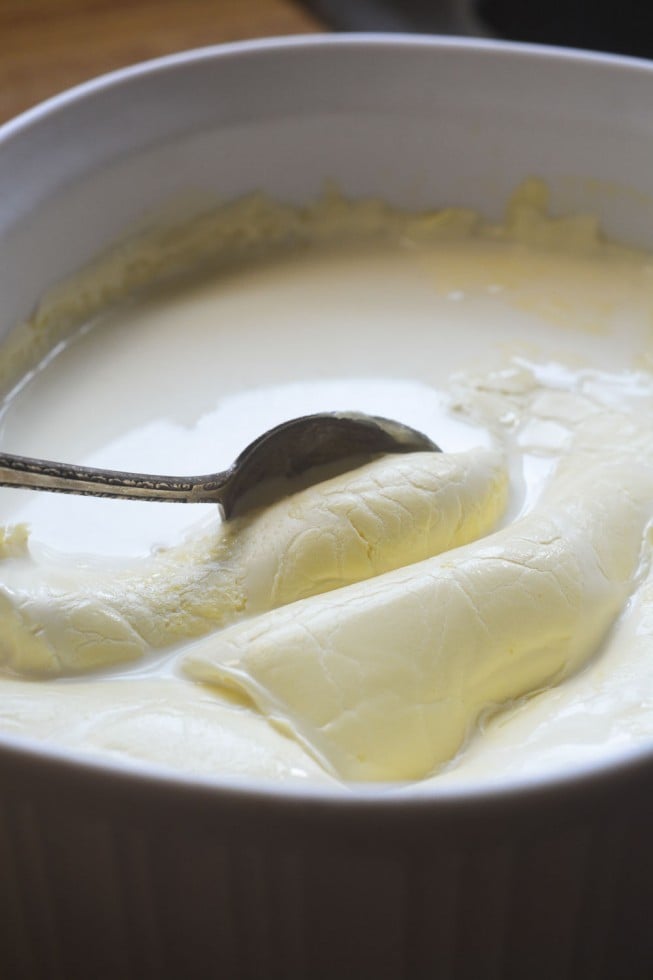
How long does clotted cream last?
Homemade clotted cream can last for up to 3-4 days when stored properly in the refrigerator. To extend its shelf life, it’s important to keep it in an airtight container and store it in the coldest part of the refrigerator, such as the back of the bottom shelf.
It’s important to note that clotted cream does not have any preservatives, so it should be consumed as soon as possible for the best flavor and texture. If you notice any changes in color, texture, or odor, discard the clotted cream immediately as it may have spoiled.
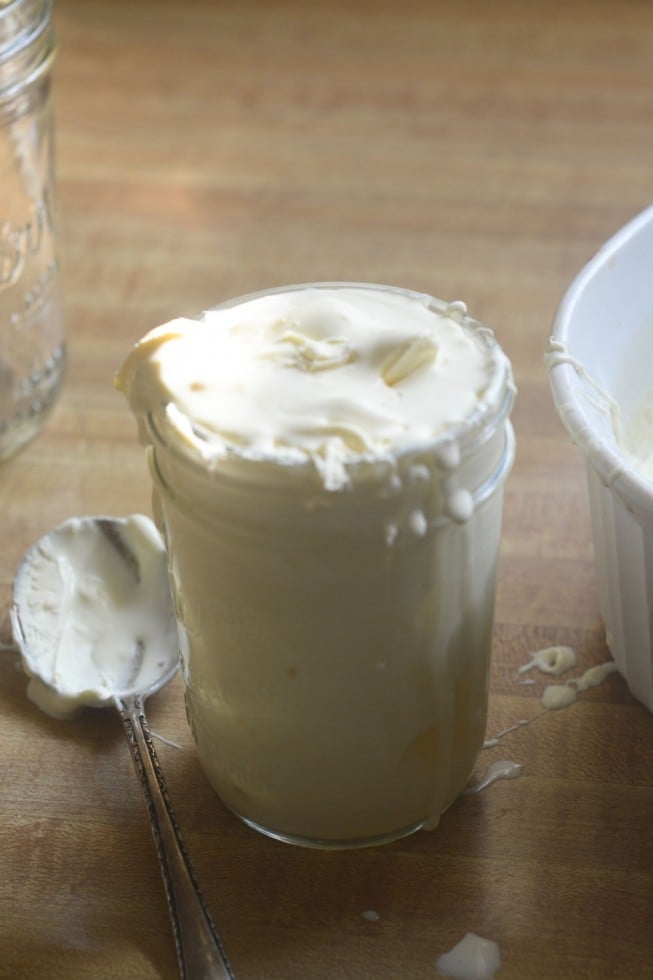
What to do with the leftover whey from making clotted cream
The leftover whey from making clotted cream can be used in a variety of ways:
- Adding it to smoothies or protein shakes for a boost of protein and nutrients.
- Using it as a substitute for milk or water in baking recipes such as bread, muffins, and pancakes.
- Using it as a marinade for meat or fish to tenderize and add flavor.
- Adding it to soups or stews for added richness and flavor.
- Using it as a liquid base for making homemade ricotta cheese or other soft cheeses.
- Feeding it to pets, as it is a good source of protein and nutrients for animals.
Note: It’s important to keep in mind that the leftover whey should be used or stored promptly to avoid spoilage. It can be stored in the refrigerator for up to a week or frozen for longer storage.
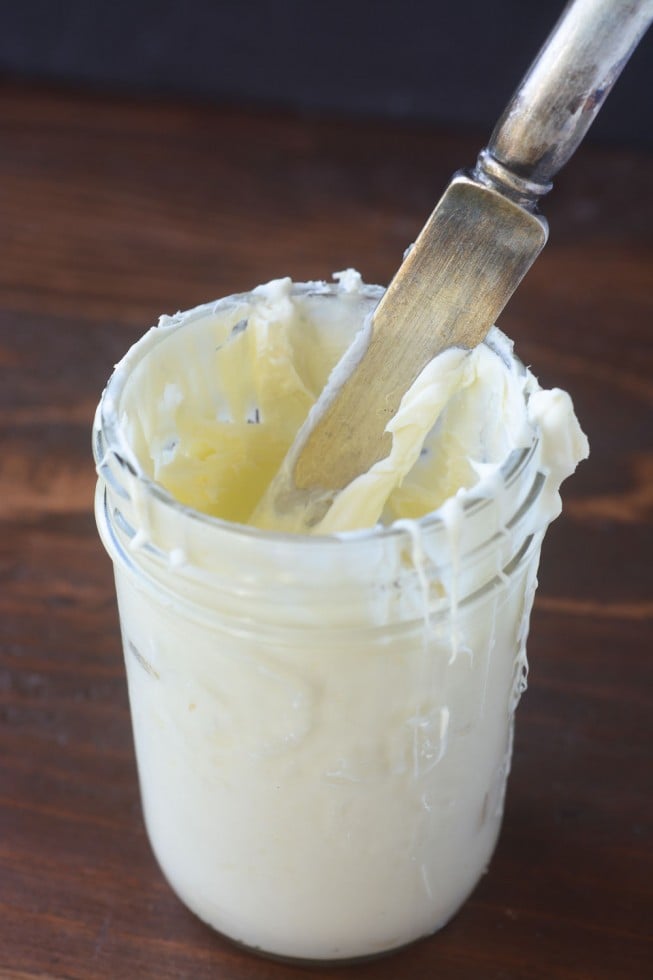
I can’t say enough good things about this project, the results far exceeded my expectations and it was absurdly easy. The only catch is that you can’t use ultra-pasteurized cream, which is cream that’s been processed for a longer shelf life. Many stores only sell ultra-pasteurized cream, so you have to search a bit for regular cream. I found mine at Whole Foods. Just read the labels… if it doesn’t say ultra-pasteurized on the label, you’re good to go.
can you make clotted cream with ultra-pasteurized cream?
Some readers in the comments below have had success with ultra-pasteurized cream. It is possible to make clotted cream from ultra-pasteurized cream, but it may be more difficult to achieve the desired texture and flavor. Ultra-pasteurization is a process that heats the cream to a higher temperature than regular pasteurization, which extends its shelf life but can also alter the proteins and enzymes in the cream. This can make it more difficult for the cream to form clots, which are necessary for making clotted cream.

What to eat with your homemade clotted cream
You will definitely want to make scones to go with your homemade clotted cream. I have lots of recipes for scones on the blog, but a simple one to start with is my Classic Cream Scones Recipe.
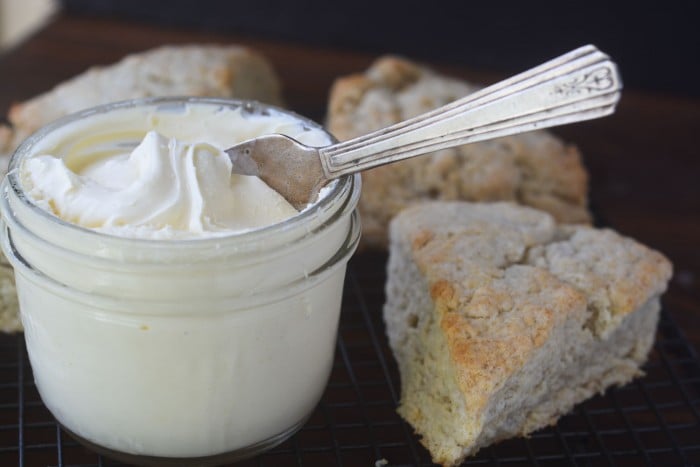
Tips for making clotted cream
- Make sure your cream is not ‘ultra pasteurized’, you will need to find regular pasteurized cream at a Whole Foods or other similar store. Ultra pasteurized cream has been treated in a way that prevents it from ‘clotting’.
- An oven thermometer is an essential kitchen tool, and really comes in handy for this project. If your oven is too cool or too hot your homemade clotted cream will not ‘clot’. Set your oven to 180F and then check the thermometer. You can adjust up or down as necessary.
- If your oven does not go down as low as 180F you can try one of my other methods for making clotted cream:

Homemade Clotted Cream
Video
Equipment
- a heavy casserole dish
Ingredients
- 2 pints heavy cream or whipping cream (double cream in the UK), avoid ultra-pasteurized cream for best results.
Instructions
- set your oven to 180F
- Pour the cream into the casserole dish. It should come up about 1-3 inches on the side.
- Set the dish, uncovered, in the oven and leave undisturbed for 12 hours. Be sure to leave the oven on the whole time. I do this overnight.
- Remove the dish from the oven and set to cool. Then cover and refrigerate. Note: the cream may seem thin at this point, but is going to thicken considerably overnight.
- The next morning scoop the thickened cream into a jar or jars, and cover and put back in the refrigerator. You can use the leftover cream for baking..
- Spread the clotted cream on freshly baked scones.
Nutrition


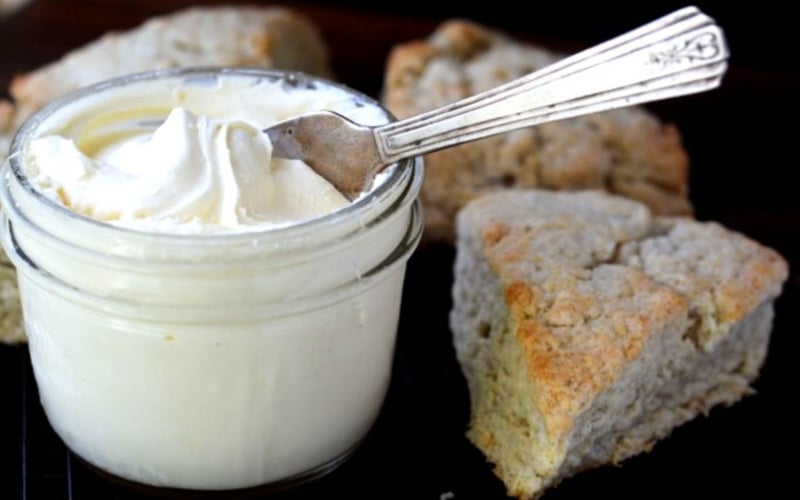












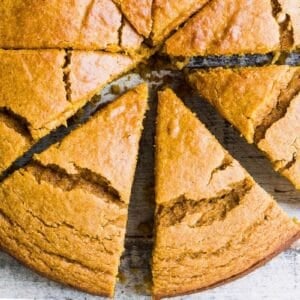







180 degrees is high?
Do you mean Celsius?
180F is the temperature for making the clotted cream. That’s usually the lowest most ovens can go. Some do not go that low, in which case you can use one of my other methods for making clotted cream, either on the stove top, or in the Instant Pot.
This is perfect, Honest to goodness real clotted cream!
I tried this recipe a few years ago. The first time I tried it I accidentally made butter. I wanted to take the finished cream and make it smooth. I put it in a container and used a stick blender and I churned it into butter.
I have made this clotted cream several times since then, but never used a blender again.
I’m glad you finally got the result you were after Donna. I have had success with an immersion blender but I run it, literally, for like a second.
Excellent recipe!
I couldn’t find cream that was not ultra pasteurized, so I had to do with ultra pasteurized heavy cream and it tastes same.
I would like to try it with unpasteurized or low pasteurized cream but haven’t been able to find it anywhere. Does anyone know where to find it?
Thank you.
Excellent recipe!
I couldn’t find cream that was not ultra pasteurized, so I had to do with ultra pasteurized heavy cream and it tastes same.
I would like to try it with unpasteurized or low pasteurized cream but haven’t been able to find it anywhere. Does anyone know where to her it?
Thank you.
in your instructions you said to leave the casserole uncovered but in the video, you covered then put in the oven. Which is better
I leave it uncovered, but you can go either way.
I just came across of this simply recipe. The easiest I’ve seen. I have an odd question for you. I have some family members that are lactose intolerant. Is there a way to make clotted cream that is lactose free?
Hi Debra ~ one pound makes about 4 cups chopped rhubarb, so for 2 pounds it would be about 8 cups. This is very forgiving, though.
Using lactose-free cream to make clotted cream should technically be possible, since removing lactose doesn’t affect the fat content, which is the critical part of this recipe. But I haven’t tried so I can’t say for sure. Let us know if you experiment.
I wasn’t able to get this version to work, but I am sure it was because of the availability of the heavier fatted creams. HOWEVER, your stove top version is AMAZING, is simple and it works every time!!!!!
Ok my oven would only go down to 200. When 12hours were done I had a brown top on it. So when it thickens do I skim it off ? Thanks
As a recent commenter from Cornwall mentioned, the British expect a nice golden crust on their clotted cream, so you can scoop it up into jars with the whiter, creamier portions.
I’m Cornish, grew up there, now live in Devon, and have loved clotted cream ‘forever’. Virtually every farm kitchen had a pan of cream simmering at the back of the stove when I was a kid. Your recipes are exactly right – with one comment though. ‘Our’ cream in SW UK always has a thick slightly crumbly yellow crust (almost like dryish butter-crumbs) on the top. Did you know that clotted cream can be frozen quite effectively? So if you have a bit too much (if ‘too much’ is ever possible), freeze it on the day of making. For sheer decadence, try spreading a layer on peppermint chocs, or putting it on frozen cherries (must have NO stones in ’em) you’ve heated up – plus a drop of cherry brandy in the cherries with the cream. It goes with anything, and in the past was even put into Cornish pasties ‘to make the gravy’!